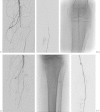Treatment of infrapopliteal arterial occlusive disease in critical limb ischemia
- PMID: 25435663
- PMCID: PMC4232435
- DOI: 10.1055/s-0034-1393974
Treatment of infrapopliteal arterial occlusive disease in critical limb ischemia
Figures

References
-
- Norgren L, Hiatt W R, Dormandy J A. et al.TASC II Working Group. Inter-Society Consensus for the management of peripheral arterial disease (TASC II) Eur J Vasc Endovasc Surg. 2007;33 01:S1–S75. - PubMed
-
- Hirsch A T, Haskal Z J, Hertzer N R. ACC/AHA 2005 guidelines for the management of patients with peripheral arterial disease (lower extermity, renal, mesenteric, and abdominal aortic): executive summary: a collaborative report from the American Association for Vascular Surgery/Society for Vascular Surgery, Society for Cardiovascular Angiography and Interventions, Society for Vascular Medicine and Biology, Society of Interventional Radiology, and the ACC/AHA Task Force on Practice Guidelines (Writing Committee to Develop Guidelines for the Management of Patients With Peripheral Arterial Disease) J Am Coll Cardiol. 2006;47:1239–1312. - PubMed
-
- Romiti M, Albers M, Brochado-Neto F C, Durazzo A E, Pereira C A, De Luccia N. Meta-analysis of infrapopliteal angioplasty for chronic critical limb ischemia. J Vasc Surg. 2008;47(5):975–981. - PubMed
-
- Spinosa D J, Harthun N L, Bissonette E A. et al.Subintimal arterial flossing with antegrade-retrograde intervention (SAFARI) for subintimal recanalization to treat chronic critical limb ischemia. J Vasc Interv Radiol. 2005;16(1):37–44. - PubMed
-
- Martens J M, Knippenberg B, Vos J A, de Vries J P, Hansen B E, van Overhagen H. PADI Trial Group . Update on PADI trial: percutaneous transluminal angioplasty and drug-eluting stents for infrapopliteal lesions in critical limb ischemia. J Vasc Surg. 2009;50(3):687–689. - PubMed
Publication types
LinkOut - more resources
Full Text Sources
Other Literature Sources
Medical

